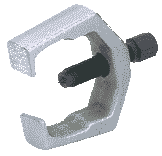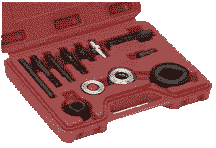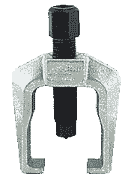PLACE AN ORDER |
StangerSite © 2008 All pictures, diagrams, text and illustrations are the property of StangersSite and may not be copied or reproduced without the express written permission of the Webmaster |
SPECIAL TOOLS |
SPECIAL TOOLS for STEERING & SUSPENSION |
NO PICKLE FORKS ALLOWED !!! |
Under no circumstances should you use a "pickle fork" to remove or separate suspension
of steering components. Use of such a tool will almost always damage
the parts it is used on. Even if you do not intend to re-use the parts
you are removing, a pickle fork will damage other parts. Even though pickle forks are used in shops and dealerships around the country, it is not the proper tool to disassemble steering components. At least half of all the physical damage a rebuilder sees each day is due to the use of this foul and unholy instrument. It is used only by the cheap, the lazy, the ignorant and the unskilled. No respectable mechanic would use one. |
1) Using a pickle fork to remove a Pitman Arm from a Steering Box will pull down hard
on the sector shaft, forcing it into the rack block under much greater pressure than it is in normal use. It can also damage the splines on the sector shaft and cause gouging and burrs on the pitman arm. 2) Using a pickle fork to remove the Ball Stud from the Pitman Arm will cause the ball of the stud to tear out of the bushing it sits in. This will destroy the bushing, jam it up inside the sleeve so it won't slide and will have to be hammered out, and will damage the sleeve area to where a new bushing will not fit and slide inside of it. 3) Using a pickle fork to remove the swivel stud of a Power Cylinder from the centerlink will put severe outward pressure on the stud in its socket - many times more than it ever sees in service. It will probably loosen the swivel stud in its socket, gouge the socket edge which may limit the studs movement , and almost certainly destroy the rubber boot surrounding the stud. |
That being said, there are tools specially suited for each of the tasks listed above.
Proper use of these tools will easily disassemble the parts and leave them
in unmarked and re-useable condition. If you do not have access to these
tools, you can often borrow or rent them from your favorite parts store.
Many chain shops like Auto Zone and Chief will loan or rent you these tools.
They are also available new at reasonable prices at Harbor Freight.
Though they may not be the best quality or made for everyday use, they are good
enough for the weekend mechanic. |
Pitman Arm Remover |
Some people will try to remove a Pitman Arm from the Sector Shaft of the steering
box with a 2 or 3-jaw gear puller. These will generally not work on a Pitman Arm
because the edges of the arm are rounded and the jaws of a gear puller tend
to spread and slip off of the arm. Since it usually takes a great deal of
effort to get a Pitman Arm off of the tapered splines of the Sector Shaft (where
it may have been attached for over thirty years), it is best to use the right
tool. Below are two examples of a dedicated Pitman Arm Puller. The one on the left is the most common and can usually be borrowed or rented from someone like Autozone or Chief Auto Parts. It will remove most Pitman Arms from the Ssteering box shaft. Occasionally, a Pitman Arm is so tight on the sector shaft that the standard puller jaws will spread or break. For this reason there is a heavy-duty Pitman Arm Puller like the one on the right. The jaws are movable and can be adjusted inward for maximun grip on the Pitman Arm. If you do not have access to one of these tools, it is easy and inexpensive to buy them from someone like Harbor freight. Listed below are the part numbers and prices of these tools. They can also be used to remove other parts from the centerlink without damage. |

STANDARD PITMAN ARM PULLER |
Harbor Freight Part # 1752-2VGA $ 6.99 |
Tie Rod End / Power Cylinder Stud Remover |
This handy tool is a 2-jaw puller that is designed to keep the jaws from spreading
and slipping off of the centerlink. It acts like a press and pushes the studs
out - usually with a sharp pop. It puts no stress on the socket of the stud and
will not damage the threads. |

PULLEY REMOVER AND INSTALLER SET |
Harbor Freight Part # 40749-1VGA $ 9.99 |
Power Steering Pump Pulley Remover and Installer |
The pulley on a Ford power steering pump is pressed onto the input shaft. You can't
remove a pump pulley from a Ford pump without the right tool, but you can destroy
a pulley finding this out. The pulleys are designed with a special grooved
snout just for removal and installation. These tools will smoothly remove a pulley
a hundred times without ever leaving a scratch. The first design shown on the lower left is a specialized jaw puller made just for the snout on a pump pulley. While a bit flimsy, it will do the job. The best design is the one shown on the right below. It uses a coupler that completely surrounds the pulley snout and pulls the pulley off. It spreads the strain around the full diameter of the snout and won't hardly scratch the paint. |
The pulley is press-fit onto the pump shaft. The pulley cannot be pressed onto the
shaft using a hydraulic press. This will force the shaft into the rotor of the
internal campack and break it. The pulley must be pressed on without any pressure
of the shaft on the internals of the pump. This requires using a tool to hold
the shaft and to put pressure against while pressing on the pulley. This is
why the pump shaft is threaded inside the end. These threads are to hold a bolt
by which the pulley can be pressed on with. In most cases, pulley installation is a one-time thing and a simple Bolt & Washer setup will work just fine. For those who find themselves installing pulleys on a more regular basis, or have a particulary tight pulley, a dedicated Pulley Installation Tool is the prime setup. These can often be rented or borrowed from an auto parts supply store or purchased from a tool vendor. |
Tools and More Part # OEM-25297 $ 14.99 |
TIE ROD END PULLER |
Tools and More Part # 5747 MIT $ 13.50 |

Where To Buy Tools |
The tools above are available from many sources and come in many levels of quality.
Those particularly shown above are a cheaper quality of tool, but are adequate
for the home emchanic where they will only be used a few times. Even a cheap
tool is better than using the wrong tool. You can buy these tools locally at Harbor Freight or online. |
AutoZone Loan-A-Tool Program |
Loacl AutoZone stores have a special program where you can put down a deposit, borrow
a specialty tool, use it, then return it for a refund of your deposit. This
program enables you to borrow a professional tool to do a job without having
to purchase one yourself. Check with your local AutoZone store for details. |